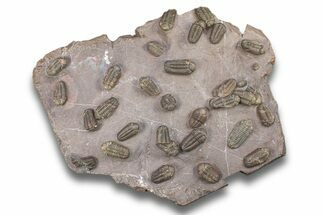This Specimen has been sold.
Triple Austerops Trilobite - Jorf, Morocco
This is a trio of nicely preserved phacopid trilobites from Jorf. The two smaller ones look like Austerops smoothops, the other one appears to be a different species.
The rock from the Jorf area is extremely hard with almost a glass-like texture to it. This makes it very time consuming to prepare compared to other localities. The shell tends to be transluscent so the trilobites take on much of the color of the rock underneath.
The rock from the Jorf area is extremely hard with almost a glass-like texture to it. This makes it very time consuming to prepare compared to other localities. The shell tends to be transluscent so the trilobites take on much of the color of the rock underneath.
About Trilobites
Trilobites are an extinct class of marine arthropods that thrived for nearly 270 million years, from the early Cambrian to the end of the Permian period (around 521 to 252 million years ago). They are one of the most successful and diverse groups in the history of life, with over 25,000 described species spanning a wide range of sizes, shapes, and ecological niches. Known for their distinctive, segmented exoskeletons, trilobites provide invaluable insights into the evolutionary history of arthropods and the dynamics of ancient marine ecosystems.
Trilobites are an extinct class of marine arthropods that thrived for nearly 270 million years, from the early Cambrian to the end of the Permian period (around 521 to 252 million years ago). They are one of the most successful and diverse groups in the history of life, with over 25,000 described species spanning a wide range of sizes, shapes, and ecological niches. Known for their distinctive, segmented exoskeletons, trilobites provide invaluable insights into the evolutionary history of arthropods and the dynamics of ancient marine ecosystems.
SPECIES
Austerops
LOCATION
Jorf, Morocco
FORMATION
Bou Tchrafine Formation
SIZE
2.4", 1.45" & 1.4", on 5.3x4" rock
CATEGORY
SUB CATEGORY
ITEM
#95483
We guarantee the authenticity of all of our specimens.
 Reviews
Reviews






















